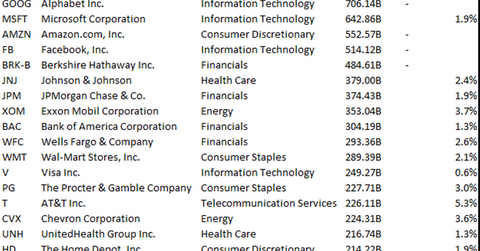What Are the Dividend Yields of the Top 10 Mega-Cap Stocks?
Donald Trump’s promises of financial deregulation, infrastructure spending, and tax cuts played a major role in the stock market rally this year.
Dec. 12 2017, Published 1:48 p.m. ET

A curtain raiser
Information technology (or IT) companies followed by financials companies form the majority of the top 21 S&P 500 companies ranked in order of market capitalization. We’ll discuss the top 11 companies depicted in the chart below in the upcoming parts of the series. We’ll follow this series with another series that discusses the next ten companies.
Donald Trump’s promises of financial deregulation, infrastructure spending, and tax cuts played a major role in the stock market rally this year. The year saw a tech rally driven by FAANG stocks, which include Facebook (FB), Apple (AAPL), Amazon (AMZN), Netflix, and Alphabet (GOOG). The energy sector was affected by lower oil prices perpetrated by oversupply leading to production cuts. All of these trends wreaked havoc on companies like ExxonMobil (XOM) and Chevron (CVX). The telecommunication service sector was rendered vulnerable by tariff wars affecting the profits of Verizon Communications (VZ) and AT&T (T). Health care, utilities, and consumer staples, or the defensive sectors, have performed well due to the positive market sentiment. The same can be said for the cyclical sectors like materials, consumer discretionary, and financials (including real estate).
Dividend yield and price performance of the sectors
Telecommunication services followed by utilities and consumer staples were the sectors with the highest dividend yields, while IT was the sector with the lowest dividend yield. IT followed by health care have recorded the highest price gains on a year-to-date (or YTD) basis, which affected their dividend yield. Telecommunication services followed by energy have been the top losers in terms of price, which explains their high dividend yields. The rest of the sectors, apart from these two, were part of the stock market rally this year.
How do the companies compare to the broad indexes?
The S&P 500 (SPX-INDEX) (SPY) offers a dividend yield of 2.3%, a PE ratio of 23.3x, and a YTD return of 18.4%. The Dow Jones Industrial Average (DJIA-INDEX) (DIA) has a dividend yield of 2.2%, a PE ratio of 21.9x, and a YTD return of 23.1%. The NASDAQ Composite (COMP-INDEX) (ONEQ) has a PE ratio of 25x and a YTD return of 27.1%.
The Global X SuperDividend ETF (SDIV) is a dividend ETF with 51%, 15%, and 13% exposure to real estate, consumer cyclical, and financials, respectively. It has a PE of 11.6x and a dividend yield of 6.8%. The FlexShares International Quality Dividend Index Fund (IQDF) is a dividend ETF with 25% and 10% exposure to the financials and consumer cyclical sectors, respectively. It has a PE of 18.7x and a dividend yield of 3.6%.
